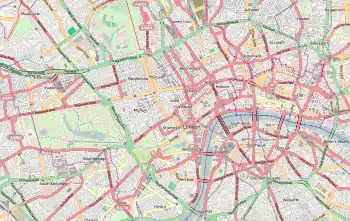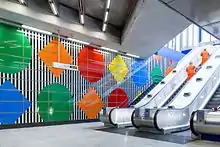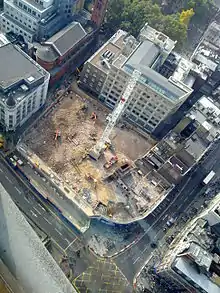Tottenham Court Road tube station
Tottenham Court Road is a London Underground station in St Giles in the West End of London. It is served by the Central line and the Charing Cross branch of the Northern line. The station will also be served by the Elizabeth line when the core section opens.[4]
| Tottenham Court Road | |
|---|---|
 Tottenham Court Road's new main entrance, opened in December 2015 | |
 Tottenham Court Road Location of Tottenham Court Road in Central London | |
| Location | St Giles |
| Local authority | London Borough of Camden |
| Managed by | London Underground |
| Owner | Transport for London |
| Number of platforms | 4 |
| Fare zone | 1 |
| London Underground annual entry and exit | |
| 2015 | |
| 2016 | |
| 2017 | |
| 2018 | |
| 2019 | |
| Key dates | |
| 30 July 1900 | Opened (CLR) |
| 22 June 1907 | Opened (CCE&HR) |
| Other information | |
| External links | |
| WGS84 | 51.5162°N 0.1309°W |
On the Central line it is between Oxford Circus and Holborn, and on the Northern line it is between Leicester Square and Goodge Street. The station is located at St Giles Circus, the junction of Tottenham Court Road, Oxford Street, New Oxford Street and Charing Cross Road and is in Travelcard Zone 1.
History
Central London Railway
The station opened as part of the Central London Railway (CLR) on 30 July 1900.[5] From that date until 24 September 1933,[5] the next station eastbound on the Central line was the now-defunct British Museum; the next stop in that direction is now Holborn. The platforms are under Oxford Street west of St Giles' Circus, and were originally connected to the ticket hall via lifts at the east end of the platforms. The original station building is in Oxford Street and was designed in common with other CLR stations by Harry Bell Measures. Much modified, it now forms part of the station entrance, and some elements of the original facade survive above the canopy. Apart from those very limited original features of the entrance, the station building otherwise together with a whole row of other elegant old buildings were demolished in 2009.
Charing Cross, Euston & Hampstead Railway
The Charing Cross, Euston & Hampstead Railway (CCE&HR, now part of the Northern line) arrived here on 22 June 1907[6] but used the name Oxford Street until an interchange (linking the eastbound Central line with the southbound Northern line via the ends of the platform) was opened on 3 September 1908[7] from when the present name was used for both lines. The next station north on the Northern line was originally called Tottenham Court Road,[7] but was renamed to Goodge Street at this time.
The original ticket office was directly beneath St Giles circus and was accessed from stairs on three street corners around the Circus. Its original lift shafts and emergency stairs are still extant. A set of emergency stairs can used as access down to the ends of the Northern line platform. The lift shafts are used for offices and station facilities.
Early Improvements
Like a number of other central area stations, Tottenham Court Road underwent improvements during the 1920s to replace the original sets of lifts with escalators. Works commenced in 1923; a new subsurface ticket hall, under St Giles Circus, was constructed and the escalators came into service on 28 September 1926 (upper set) and 1 February 1926 (lower set).[8] A shaft for three escalators was driven from the ticket hall under the junction down to the east end of the Central line platforms ending at an intermediate circulation space. A further pair of escalators descend from this level to the north end of the Northern line platforms. The lifts were removed and the redundant shafts were used as ventilation ducts. In 1938 a chiller plant began operating at the station. This was decommissioned in 1949.
Passenger congestion entering and leaving the Northern line platforms was partially eased by the addition of a short single escalator at the centre of the platform leading up to a passageway linking to the intermediate circulation area. However, this was in itself a cause of congestion, as traffic trying to leave the station from the Northern line found itself in the path of traffic entering and travelling to the Central line.
In 1984 the entire station was redecorated, losing the distinctive Leslie Green-designed platform tiling pattern of the Yerkes tube lines (which included the CCE&HR), and the plain white platform tiles of the CLR. The 1980s design includes panels of tessellated and hand cut smalti mural mosaic by Eduardo Paolozzi (whose signature appears at several places within the station), and is a distinct and noticeable feature of the station. The mosaic's frenetic design is intended to reflect the station's position adjacent to Tottenham Court Road's large concentration of hi-fi and electronics shops. During the expansion works for the expansion of the station for Crossrail[9] sections of the mosaic were restored, moved or replaced[10] while other section were destroyed, some sections of which have been removed to be conserved at the University of Edinburgh.[11]
Upgrade and expansion
The station had four entrances to the sub-surface ticket hall from the north-east, south-west and north-west corners of the junction and from a subway beneath the Centre Point building which starts on Andrew Borde Street. The entrances were frequently congested leading to occasions during peak periods of the day when they were briefly closed to prevent overcrowding in the station.
In the aftermath of the King's Cross fire in 1987, London Underground was recommended to investigate "passenger flow and congestion in stations and take remedial action".[12] A Parliamentary bill was tabled in 1991 to permit London Underground to improve and expand the frequently congested station, however this was not proceeded with.[13] In 2000, London Underground consulted on an station upgrade including a new larger ticket hall, new escalators and step free access, which would have taken 4 years to construct.[14]
The station was eventually reconstructed and upgraded in the mid 2010s as part of the Crossrail project,[4] with the £500m station upgrade taking 8 years.[15] The works involved building a much larger ticket hall under the forecourt of Centre Point, new sets of escalators to reach the central section of the Northern line platforms from the ticket hall, step-free access to the platforms, as well as escalators down to the eastern end of the future Crossrail station. The subway to Andrew Borde Street was replaced as part of this development.[16] To enable this expansion to occur, both the Astoria theatres and the original Central line entrance were demolished.[16]
As part of the expansion of the ticket hall, Art on the Underground commissioned an artwork by Daniel Buren, a French conceptual artist. This piece, 'Diamonds and Circles' permanent works 'in situ', was Buren's first permanent public commission in the UK.[17] The artwork comprises colourful diamond and circle shapes, which contrast with Buren's trademark stripes in black and white, fixed to internal glass walls throughout the ticket hall. The piece was completed in 2017.[18]

From 2 April until 28 November 2011, the Northern line platforms were closed for structural upgrade works and Northern line trains ran non-stop through the station.[19]
From 5 January until 7 December 2015, the Central line platforms were closed, meaning Central line trains did not stop at the station. On 12 January 2015, the first part of the new ticket hall opened for the first time. The station which previously required commuters going through the Central line level concourse to get to the Northern line, via a one-way system, now has escalators directly to Northern line level followed by stairs to the platforms. The escalators are among the longest in the tube, and take a minute top to bottom.[20]
Current developments
Crossrail
In addition to the eastern ticket hall expansion, a new western entrance and ticket hall is being built under Dean Street[21] as part of the Crossrail project, leading to both the Crossrail platforms and to the parallel Central line platforms.
The Crossrail station 'box' was constructed as part of the Underground ticket hall works, and completed in an un-fitted form by 12 January 2015.[22] Similar to the situation with Thameslink platforms at St Pancras, the line developers are responsible for the fitting-out works which create the actual station infrastructure.[22]
Construction Gallery
 September 2009
September 2009 September 2009
September 2009 June 2010
June 2010 June 2010
June 2010 July 2011
July 2011
Future developments
Crossrail 2
The proposed Chelsea-Hackney line, now known as Crossrail 2, if built, will have a station at Tottenham Court Road, and the development plans include facilities to take account of this. This would be the only planned interchange between Crossrail 1 and Crossrail 2. A massive boost in capacity to the existing station will be needed to host both lines. The station was safeguarded as part of the route in 1991 and 2007.[23] Redevelopment of the station will include space for platforms on the line.
In popular culture
- The station was used for a sequence in the 1981 film An American Werewolf in London.[24]
- A scene in the 2008 film The Bank Job is set in the station, though it was shot at Aldwych tube station.[25]
- A scene in the musical We Will Rock You is set in the station; the musical played across the street at the Dominion Theatre from 2002 to 2014.[19][26]
Gallery
| Wikimedia Commons has media related to Tottenham Court Road tube station. |
 Street level looking down New Oxford Street
Street level looking down New Oxford Street Westbound Central line platform, looking east (before refurbishment)
Westbound Central line platform, looking east (before refurbishment) Northbound Northern line platform, looking north (before refurbishment)
Northbound Northern line platform, looking north (before refurbishment) Mosaic decoration by Sir Eduardo Paolozzi on northbound Northern line platform
Mosaic decoration by Sir Eduardo Paolozzi on northbound Northern line platform Roundel on northbound Northern line platform
Roundel on northbound Northern line platform
Connections
London Buses routes 1, 7, 8, 14, 19, 24, 29, 38, 55, 73, 98, 134, 176 and night routes N1, N20, N5, N7, N8, N19, N20, N29, N35, N38, N41, N55, N68, N73, N98, N171, N207, N253 and N279 serve the station. Reduced bus services operate on Sundays.
References
- "Multi-year station entry-and-exit figures (2007–2017)" (XLSX). London Underground station passenger usage data. Transport for London. January 2018. Retrieved 22 July 2018.
- "Station Usage Data" (CSV). Usage Statistics for London Stations, 2018. Transport for London. 21 August 2019. Retrieved 27 April 2020.
- "Station Usage Data" (XLSX). Usage Statistics for London Stations, 2019. Transport for London. 23 September 2020. Retrieved 9 November 2020.
- "Tottenham Court Road station". Crossrail. Retrieved 19 September 2017.
- Clive's Underground Line Guides – Central Line, Dates
- Clive's Underground Line Guides – Northern Line, Dates
- Rose, Douglas (1999). The London Underground, A Diagrammatic History. Douglas Rose. ISBN 1-85414-219-4.
- Railways Through The Clay; Croome & Jackson; London; 1993; p169
- Aicha Zaa, Will Hurst (2 February 2015). "Campaigners 'disgusted' as builders dismantle Paolozzi murals at Tottenham Court Road". London Evening Standard. Retrieved 21 August 2017.
- "Recreating Paolozzi's great Tottenham Court Road Mosaics". Gary Drostle. 2 December 2016. Retrieved 8 May 2020.
- "Tube station mosaics to be seen in new light in artist's home city". Edinburgh College of Art. University of Edinburgh. Archived from the original on 15 September 2015. Retrieved 26 August 2015.
- 1929-, Fennell, Desmond (1988). Investigation into the King's Cross underground fire. Great Britain. Department of Transport. London: [For] Department of Transport [by] H.M.S.O. ISBN 0101049927. OCLC 19271585.CS1 maint: numeric names: authors list (link)
- "London Underground (Safety Measures) Act 1991". www.legislation.gov.uk. Retrieved 19 September 2017.
- "Improvements to Tottenham Court Road station". London Transport. 28 February 2000. Archived from the original on 20 June 2000. Retrieved 10 March 2020.
- Dick Murray (10 February 2017). "Tottenham Court Road station's £500 million revamp completed as entrances open". London Evening Standard. Retrieved 21 August 2017.
- Crossrail – Proposal for eastern ticket hall Archived 28 September 2007 at the Wayback Machine
- Daniel Buren (3 July 2017). "Diamonds and Circles, works in situ". Art on the Underground. Retrieved 21 August 2017.
- Alice Morby (12 July 2017). "Daniel Buren completes installation at Tottenham Court Road tube station". Dezeen.com. Retrieved 21 August 2017.
- Martland, John (16 January 2004). "We Will Rock You". The Stage Newspaper Limited. Archived from the original on 30 September 2007. Retrieved 1 April 2011.
- Geoff Marshall (12 January 2015). "New Tottenham Court Road Station Opens". Londonist. Retrieved 21 August 2017.
- Crossrail – Proposal for western ticket hall Archived 28 September 2007 at the Wayback Machine
- "New Ticket Hall opens at Tottenham Court Road". Railway Gazette. 12 January 2015. Retrieved 23 January 2015.
- Archived 27 June 2008 at the Wayback Machine
- "An American Werewolf in London [1981 feature film]". www.nickcooper.org.uk. 14 April 2004. Retrieved 21 August 2017.
- "The London Underground in Films & TV". www.nickcooper.org.uk. Retrieved 14 January 2019.
- We Will Rock You to close after an astonishing 12 years – bestoftheatre.co.uk
External links
| Wikimedia Commons has media related to Tottenham Court Road tube station. |
- London Transport Museum Photographic Archive Central line station building in 1914
- City of Westminster, Draft Planning Brief – Crossrail: Tottenham Court Road Station (Eastern Ticket Hall), May 2005, Retrieved 31 January 2008
- Photos of Paolozzi's mosaics in the station
- Conservation of the TCR Station Mosaics
- Images from An American Werewolf in London prior to installation of Paolozzi mosaics
- Rebuilding work and schedule (Transport for London)
- Restoration and rebuild of Central Line Paolozzi mosaics by mosaic artist Gary Drostle
| Preceding station | Following station | |||
|---|---|---|---|---|
| Central line | ||||
| Northern line Charing Cross Branch | ||||
| Future Development | ||||
| Preceding station | Following station | |||
| Crossrail Elizabeth line | ||||
| Crossrail Line 2 | ||||
| Former service | ||||
| Preceding station | Following station | |||
towards Ealing Broadway | Central line | towards Liverpool Street |
||